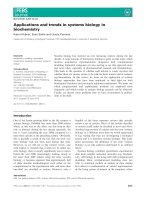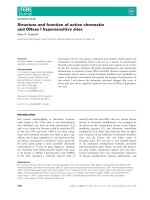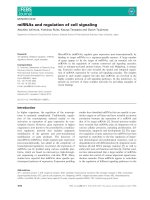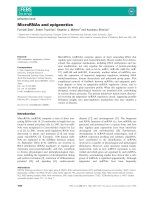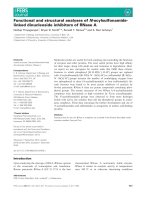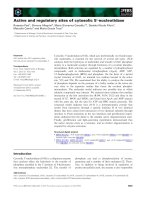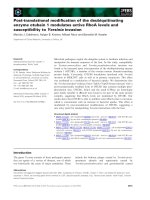Tài liệu Báo cáo khoa học: Biochemical and molecular characterization of hazelnut (Corylus avellana) seed lipoxygenases pdf
Bạn đang xem bản rút gọn của tài liệu. Xem và tải ngay bản đầy đủ của tài liệu tại đây (1.59 MB, 11 trang )
Biochemical and molecular characterization of hazelnut
(
Corylus avellana
) seed lipoxygenases
Angelo Santino
1
, Angelo De Paolis
1
, Antonia Gallo
1,
*, Angela Quarta
1
, Rod Casey
2
and Giovanni Mita
1
1
Institute of Sciences of Food Production C.N.R. Section of Lecce, Italy;
2
John Innes Centre, Norwich, UK
Plant lipoxygenases (LOXs) are a class of dioxygenases
which display diverse functions in several physiological
processes such as growth, development and response to
biotic and abiotic stresses. Even though LOXs have been
characterized from several plant species, the physiological
role of seed LOXs is still unclear. With the aim to better
clarify the occurrence of LOXs and their influence on
hazelnut seed quality, we carried out the biochemical and
molecular characterization of the main LOX isoforms
expressed during seed development. A genomic clone con-
taining a complete LOX gene was isolated and fully char-
acterized. The 9887 bp sequence reported contains an open
reading frame of 5334 bp encoding a putative polypeptide of
99 kDa. Semiquantitative RT-PCR carried out from RNAs
extracted from seeds at different maturation stages showed
that LOXs are mainly expressed at early developmental
stages. These results were confirmed by LOX activity assays.
Biochemical characterization of the reaction products of the
hazelnut LOX indicated that it is a 9-LOX. Two cDNAs
were isolated by RT-PCR carried out on total RNA from
immature hazelnut seeds. Sequence analysis indicated that
the two cDNAs are highly homologous (91.9% degree of
identity) and one of these corresponded exactly to the
genomic clone. The deduced amino acid sequences of the
hazelnut LOXs showed that they are closely related to
a previously reported almond LOX (79.5% identity) and, to
a lesser extent, to some LOXs involved in plant responses
to pathogens (cotton and tobacco LOXs, 75.5 and 74.6%
identity, respectively). The physiological role of hazelnut
LOXs and their role in influencing seed quality are also
discussed.
Keywords: Corylus avellana; hazelnut; lipoxygenases; seed
quality.
Lipoxygenases (LOX, EC 1.13.11.12) are a class of
widespread dioxygenases that catalyze the addition of
oxygen to polyunsaturated fatty acids containing a cis,cis-
1,4-pentadiene structure. The hydroperoxides produced by
the LOX reaction are the starting point for a series of
other enzymatic reactions which lead to the synthesis of a
group of biologically active compounds collectively named
oxylipins. In animal cells, the LOX pathway has been
extensively studied as it is responsible for the synthesis of
leukotrienes and lipoxins belonging to the eicosanoid
family which are involved in many physiological processes
[1]. In plants the biosynthesis of phytooxylipins is initi-
ated by the oxygen insertion at C-9 or C-13 of linoleic
(C18 : 2) or linolenic acids (C18 : 3). For this reason plant
LOXs are commonly referred as 9-LOXs or 13-LOXs.
Both 9- or 13-hydroperoxides are further converted to
different compounds through the action of the other
enzymes belonging to different branches of the LOX
pathway (hydroperoxide lyase, allene oxide synthase,
divinyl ether synthase, reductase, peroxygenase). At the
end of these enzymatic reactions the molecules synthesized
display a wide variety of physiological roles in plant
development and response to biotic and abiotic stresses. In
this context lipoxygenases, providing the substrates for the
activity of all the enzymes located downstream on the
pathway, have a primary role in the biosynthesis of
phytooxylipins and can affect their availability inside the
plant cell. The biological role of specific LOX isoforms
has been recently clarified by an antisense approach and
their depletion was able to influence plant development or
pest/pathogen resistance [2,3]. Transgenic potato plants
depleted in the expression of a specific 9-LOX showed an
abnormal tuber development [4]. Furthermore Arabidopsis
and potato transgenic plants with diminished levels of
specific chloroplastic LOXs have reduced levels of wound
inducible mRNAs [5,6].
LOXs are widespread in the seeds of many plant species;
in some cases such as soybean and other legumes they are
abundant proteins and might also function as storage,
rather than defence, proteins. This hypothesis is supported
Correspondence to A. Santino, ISPA-CNR, via Monteroni,
73100 Lecce, Italy. Fax:/Tel.: + 39 0832 420000,
E-mail:
Abbreviations:9-HODE,(9S,10E,12Z)-9-hydroxy-10,12-octadeca-
dienoic acid; 13-HODE, (13S,9Z,11E)-13-hydroxy-9,11-octadeca-
dienoic acid; LOX, lipoxygenase; RP-HPLC, reverse-phase HPLC;
SP-HPLC, straight-phase HPLC.
Enzyme: lipoxygenase (EC 1.13.11.12).
Note: a web site is available at />Note: The nucleotide sequence reported is in the EMBL database
under the accession number AJ417975.
*Present address: Institute of Sciences of Food Production C.N.R.
Bari, Italy.
(Received 18 July 2003, revised 2 September 2003,
accepted 12 September 2003)
Eur. J. Biochem. 270, 4365–4375 (2003) Ó FEBS 2003 doi:10.1046/j.1432-1033.2003.03831.x
by the results on a soybean line lacking the three LOX
isoforms which shows similar crop performances in com-
parison to control lines [7]. In other cases, LOX genes are
expressed only in early developmental stages when the
synthesis of storage proteins is not yet initiated. This has
been reported for maize L2 LOX [8], almond [9] and peanut
[10]. It was reported that peanut LOX gene is also expressed
during Aspergillus colonization and consequently a possible
defensive role was suggested for this specific isoform [10].
However the physiological role of these LOXs is largely
unclear.
Because of their role in the generation of pleasant or
unpleasant flavours and their involvement in co-oxidation
reactions leading to the bleaching of carotenoids and other
pigments, LOXs are also of great importance in food science
as they can influence the shelf life, the organoleptical and the
nutritional characteristics of seeds and other plant products
[11].
Hazelnuts are widely used in food industry with the
largest part of the world production adsorbed by the pastry
industry. Hazelnut seeds contain reasonable levels of linoleic
and linolenic acid (about 10 and 0.2%, respectively, of the
total fatty acids) and hexanal and nonanal are among the
most abundant volatile compounds detected in hazelnut oil
[12]. Nevertheless LOX activity was not detected in mature
seed [13].
Considering the importance that LOXs could display in
influencing the shelf life and the organoleptic features of
hazelnut seeds, we carried out a study to characterize
hazelnut lipoxygenases at the biochemical and molecular
level.
Materials and methods
Plant material
Hazelnut (Corylus avellana L. cv Mortarella) leaves and
seeds were harvested at different maturation stages from the
experimental field of the Istituto Sperimentale Frutticoltura,
Caserta. The leaves and shelled seeds were frozen in liquid
nitrogen and stored at )80 °C.
PCR amplification of hazelnut genomic probes
Two homologous probes (ln32, ln50) were obtained by
PCR using hazelnut genomic DNA as template, the
primers 5¢-CTATGATTATGATGTCTACAATGATTTG
GG-3¢ (ML1) and 5¢-GCAAATTCTTCATCAGTCATC
CATGCAGAC-3¢ (ML2) and the following amplification
conditions: 94 °C for 5 min (1 cycle); 94 °Cfor1min,
45 °Cfor1min,72°C for 2 min (25 cycles); 72 °Cfor
5 min (1 cycle).
Construction and screening of the hazelnut
genomic library
Hazelnut (cv Mortarella) genomic DNA was extracted from
young leaves, and used for the construction of the library as
previously described [9].
The library was screened using ln32 and ln50 digoxigenin-
labelled probes (Roche). The filters were washed at a final
stringency of 0.1· NaCl/Cit, 0.5% SDS, 65 °C. Positive
plaques were picked and subjected to two additional
screenings at the same conditions.
RNA extraction and reverse transcription (RT) PCR
analysis
Total RNA was isolated from 100 mg of hazelnut seeds
using the Rneasy plant mini kit (Quiagen) following
the manufacturer’s instructions. RT-PCR was per-
formed using 2 lg of total RNA, oligo-(dT)
18
primer and
the Superscript II Polymerase (Invitrogen) according to the
manufacturer’s instructions. The first strand cDNA was
used as template in PCR experiments with oligonucleotides
designed on the basis of the genomic sequence.
The 5¢ region of the hazelnut LOX cDNA was amplified
using the following primers: 5¢-AAGATGAAACGTG
AGACGG-3¢ (CA1); 5¢-GATGACATCTCCATGGAA
TAC-3¢ (CA2). The 3¢ region of the hazelnut LOX cDNA
was amplified using the following primers: 5¢-GTTT
GGAAGAGAGATGCTGG-3¢ (CA3); 5¢-AAAGTTTTT
AGATTGAGACACTATTGGGAATT-3¢ (CA4). PCR
conditions were as follows: 94 °C for 3 min (1 cycle);
94 °C for 45 s, 50 °Cfor45s,72°C for 2 min (30 cycles);
72 °C for 15 min (1 cycle).
The amplified fragments were cloned in pCRII-TOPO
vector (Invitrogen) and sequenced.
For the semiquantitative RT-PCR, the cDNA was
amplified with the following oligos: 5¢-GTATTCCATG
GAGATGTCATC-3¢ (CA5); 5¢-AAAGTTTTTAGATTG
AGACACTATTGGGAATT-3¢ (CA4). Actin cDNA was
amplified using the following primers: 5¢-TGGTGTTAT
GGTTGGTAT-3¢ (ACTFOR); 5¢-ACCTTCATCTTCAT
GCTG-3¢ (ACTREV).
Densitometric analysis (using a Bio-Rad Gel Doc2000
and the
QUANTITY ONE
software) was carried out on the
actin amplified fragments to normalize the amount of
cDNA to be used in further PCR experiments.
Protein extraction and lipoxygenase activity
Lipid bodies were first isolated from soluble protein
fraction as previously reported [9]. LOX activity
was assayed in total protein samples and in micro-
somal fraction obtained by centrifugation of total pro-
tein samples at 100 000 g for 30 min. The pellet
(microsomal fraction) was resuspended in 100 m
M
sodium
carbonate and the pH adjusted to 7.5 before assaying
LOX activity.
LOX activity was determined polarographically at 25 °C
with a Clark O
2
electrode using linoleic acid as substrate.
Thirty micromolar stock solution was prepared according
to [14]. The reaction mixture (1.0 mL) consisted 100 m
M
sodium phosphate buffer pH 6 containing 0.3 m
M
linoleic
acid and different amounts of protein samples. Decrease in
O
2
concentration was monitored for 3 min and the enzy-
matic activity was calculated from the initial rate of O
2
uptake. One unit of LOX activity corresponds to the intake
of 1 lmol of O
2
per minute. pH optimum of hazelnut LOX
was determined as previously described [9]. LOX activity
was also assayed spectrophotometrically monitoring the
increase in A
234
of the conjugated-diene structures as
previously described [14].
4366 A. Santino et al. (Eur. J. Biochem. 270) Ó FEBS 2003
SDS/PAGE and Western blot analysis
Total proteins (20 lg) extracted from seeds harvested at
different developmental stages were subjected to SDS/
PAGE and transferred to nitrocellulose membrane (Amer-
sham). Western blot analysis was performed using the ECL
protocol (Amersham) and a 1 : 1000 dilution of the pea
LOX antibody [15].
Identification of lipoxygenase products
Protein samples from different developmental stages were
incubated for 1 h in 1 mL of 100 m
M
sodium phosphate
buffer pH 6 containing 0.3 m
M
linoleic acid. Reaction
products were reduced with sodium borohydride, extracted
with chloroform/methanol (2 : 1, v/v) and dried. The
reaction products were resuspended in methanol/water/
acetic acid (85 : 15 : 0.1, v/v/v) and separated by reverse-
phase HPLC (RP-HPLC) using a C18 Ultrasphere column
(Beckmann, 0.46 · 25 cm) as already reported [9]. The
absorbances at 234 and 210 nm were recorded simulta-
neously. The peak adsorbing at 234 nm containing the
hydroxy-10,12-octadecadienoic acid (HODE) isomers was
collected, dried and resuspended in n-hexane/propan-2-ol/
acetic acid (100 : 2 : 0.1, v/v/v). 9-HODE and 13-HODE
were separated by straight-phase HPLC (SP-HPLC) with
a Silica Ultrasphere column (Beckmann, 0.46 · 25 cm) as
already described [9]. The enantiomer composition of
9-HODE and 13-HODE was carried out by chiral phase-
HPLC on a Chiralcel OB column (Daicel Chem. Industries,
0.46 · 25 cm, 5 lm particle size) with a solvent system of
hexane/propan-2-ol/acetic acid (100 : 5 : 0.1, v/v/v) and a
flow rate of 1 mLÆmin
)1
.
Authentic standards of 9- and 13-HODE were purchased
from ICN. HPLC analyses were carried out using a
Beckman System Gold apparatus equipped with a 126
solvent module and a 168 detector.
Extraction of genomic DNA and Southern blot analysis
Genomic DNA was extracted from young hazelnut leaves
using the Plant DNA isolation Kit (Roche). About 10 lg
genomic DNA were cleaved with EcoRI, BamHI and
HindIII, separated on a 0.8% agarose gel and transferred to
Hybond N membrane (Amersham). Hybridizations were
carried out at 65 °C overnight using homologous probes
digoxigenin labelled according to the manufacturer’s
instructions (Roche). Filters were washed at a final
stringency of 0.2· NaCl/Cit 65 °C and chemiluminescent
detection was carried out using CDP-STAR as substrate
according to the manufacturer’s protocol (Roche).
Results
Lipoxygenase gene isolation and characterization
To identify and characterize hazelnut lipoxygenases at the
molecular level, we performed PCR experiments using
hazelnut genomic DNA as template and the primers ML1
and ML2 bordering a 937-bp conserved region (2103–3039)
of the soybean LOX3 gene [16]. An amplification product
of about 700 bp was obtained in the above described
conditions. The amplified DNA was cloned and sequenced.
The results revealed that the amplification product con-
tained two different lipoxygenase sequences showing a high
degree of identity but belonging to different genes. The
amplified sequences (ln32 and ln50) were used as homolog-
ous probes to screen the hazelnut genomic library prepared
as described in methods. After three successive screenings
we isolated four different genomic clones using the ln32 and
one clone with the ln50 probe.
In order to identify a genomic clone containing a
complete LOX gene, we hybridized the DNA extracted
from all the clones with three probes corresponding to the
5¢, central and 3¢ portions of a previously isolated almond
lipoxygenase gene [9]. The results indicated that one of the
clones identified (ln32/1) possibly contained a complete
hazelnut lipoxygenase which was further characterized.
Figure 1 shows the 9887 bp characterized sequence and the
hazelnut lipoxygenase gene organization. The sequence
comprises 4180 bp 5¢-untranslated, an open reading frame
of 5334 bp encoding a putative protein with a molecular
weight of 99 kDa and a 373-bp 3¢-untranslated region. The
gene, named Lox1:Ca:1, contains nine exons and, as
already observed for other lipoxygenase genes, a very large
first intron of 1871 bp. Sequence analyses revealed that both
the homologous probes, ln 32 and ln 50, comprise exon IV
and ln 32 probe exactly matches the Lox1:Ca:1 gene from
base 6790 to base 7444.
FASTA analysis revealed that the hazelnut LOX gene
shows the highest degree of identity with a almond LOX
gene (79.5% [9]). High identity was also found towards a
Gossypium hirsutum lipoxygenase induced by bacteria
(75.5% [17]), an elicitor induced tobacco LOX (74.6%
[18]); and some potato LOXs (74–72% [19–21]).
The dendrogram reported in Fig. 2 confirmed that the
described hazelnut LOX is closely related to the almond,
Gossypium, tobacco and potato LOXs.
In the 5¢ upstream untranslated region, putative TATA
and CAAT signals are present at position 4140 ()40 from
the ATG) and 4066 ()114), respectively. In the 5¢ upstream
untranslated region, we also found four inverted repeats
(204–237 bp; 646–715; 1936–61; 2745–2923, bold in Fig. 1);
one of which is particularly large (177 bp).
LOX expression and enzymatic activity during hazelnut
seed development
Hazelnut requires more than 6 months to complete seed
development as, in Italy, it normally blossoms in December;
seeds complete their development in the middle of July and
are harvested at the end of August. The maturation stages
considered in this work were identified on the basis of seed
weight. Stage I (harvested at the end of May 2002) can be
considered the beginning of cotyledon development. After
this stage, the seeds were collected every 2 weeks until the
middle of July (stages II, III and IV).
LOX expression was monitored by semiquantitative
RT-PCR. Total RNAs extracted from different develop-
mental stages were reverse transcribed using an oligo(dT)
primer. The obtained cDNAs were used in PCR experi-
ments with the LOX primers CA4 and CA5 (matching,
respectively, from base 9488 to base 9520 and from base
8366 to base 8387 of the sequence reported in Fig. 1) and
Ó FEBS 2003 Characterization of hazelnut seed lipoxygenases (Eur. J. Biochem. 270) 4367
Fig. 1. Organization of the hazelnut lipoxygenase gene lox1:Ca:1. (A) Schematic representation of the hazelnut LOX gene indicating the translation
start and the stop codon. The introns and exons are drawn in proportion to their length. (B) Nucleotide and deduced amino acidic sequences of the
hazelnut LOX gene. The inverted repeats are in bold and their orientations are indicated by arrows. TATA and CAAT boxes and the initiating
ATG are also in bold.
4368 A. Santino et al. (Eur. J. Biochem. 270) Ó FEBS 2003
Fig. 1. (Continued).
Ó FEBS 2003 Characterization of hazelnut seed lipoxygenases (Eur. J. Biochem. 270) 4369
two primers designed on the basis of alignment results of
several plant actin genes.
The LOX amplification product showed the expected size
(836 bp) and was further characterized by sequence ana-
lysis. The actin amplified fragment was also sequenced.
As reported in Fig. 3, hazelnut LOX is mainly expressed
during early maturation stages (stages I and II). A faint
band is visible in the other maturation stages in overloaded
gels. The same RT-PCR experiments, conducted on RNA
samples from young leaves, did not reveal any expression of
this gene in this organ (data not shown).
To verify the expression of the LOX gene corresponding
to the ln50 clone, two specific oligos were designed and used
in RT-PCR experiments. In our experimental conditions we
were not able to observe any expression of this gene in seed
or in leaves (not shown).
We carried out Western blot analysis on total protein
samples from hazelnut seeds at different developmental
stages using pea LOX antibodies [15]. As reported in Fig. 3,
a polypeptide in the molecular mass range expected for
LOXs (99 kDa) was detected in protein samples from stage I
and II seeds.
To analyze LOX activity throughout seed development
we set up a procedure aimed to reduce the interference of
endogenous lipids on enzymatic assay. For this reason the
lipid bodies fraction was first removed and LOX activity
was assayed in total protein samples or in the microsomal
fraction.
The enzymatic activity was preliminarily analyzed at
different pH values (pH 5–9) and we found that the
hazelnut LOX has a pH optimum of about 6. In these
experimental conditions, LOX activity was detected in all
the developmental stages considered with a maximum in
Fig. 2. Phylogenetic tree of hazelnut LOXs.
The amino acid sequences of hazelnut lipoxy-
genases were compared with other plant
LOXs (accession numbers are in parentheses).
Thephylogenetictreewasobtainedusing
the
PHYLIP
(Phylogeny Inference Package)
program.
Fig. 3. Analysis of LOX activity and LOX gene expression in hazelnut
seed at different developmental stages. Hazelnut seeds, collected at
different maturation stages, were weighed (A) and used to extract total
proteins for LOX immunodetection and LOX activity quantification.
Twenty micrograms of total proteins were separated by SDS/PAGE,
transferred to nitrocellulose and LOX was immunodetected with a pea
LOX antibody (B). LOX activity was assayed measuring the con-
sumption of oxygen (nmolÆmin
)1
Æmg
)1
protein) with a Clark electrode
using linoleic acid as a substrate (C). cDNAs were generated using an
oligo(dT)
18
primer and total RNA extracted from the different mat-
uration stages. PCR experiments were carried out with LOX specific
primers (D) or with actin specific primers as internal control (E).
4370 A. Santino et al. (Eur. J. Biochem. 270) Ó FEBS 2003
stage I. After this stage it declined throughout seed
development and was negligible in mature seed (Fig. 3).
We also tested the presence of LOX activity in either the
microsomal or the lipid bodies fractions (data not shown).
In both these fractions, low levels of LOX activity were
recorded but at present it is unclear if the same LOX
isoforms found in the soluble fraction are responsible for
this activity or if it derives from other isoforms.
Plant LOXs are usually classified as 9-LOXs and
13-LOXs on the basis of their product specificity. In order
to better characterize the hazelnut LOX we analyzed by RP-
HPLC the reaction products using linoleic acid as substrate.
The reaction products were reduced with sodium boro-
hydride and separated by RP-HPLC. The peak adsorbing
at 234 nm containing the hydroperoxides was collected and
subjected to SP-HPLC to separate 13- and 9-HODE. The
retention times of the reaction products of the hazelnut
LOX were compared with the reaction products of soybean
LOX type I and authentic standards of 9- and 13-HODE.
As shown in Fig. 4, 9-HODE is the main product of the
hazelnut LOX reaction (about 70% of total hydroper-
oxides). We carried out chiral-phase HPLC on both 9- and
13-HODE to separate R and S enantiomers. As reported in
Fig. 4 the products of hazelnut LOX are predominantly in
the S configuration indicating that these compounds derive
from the activity of a specific lipoxygenase.
Similar results were obtained using linolenic acid as
substrate (data not shown). From these results we can
conclude that a 9-LOX is largely responsible for the LOX
activity in immature hazelnut seed.
In order to correlate LOX activity and the production of
C
6
and C
9
aldehydes deriving from the activity of other
enzymes of the LOX pathway, we carried out a gas-
chromatographic analysis of the head space volatiles
compounds present in the hazelnut seeds at different
developmental stages. Both C
6
and C
9
aldehydes (and the
corresponding alcohol) were detected in all the samples and,
similarly to the pattern of LOX expression and activity,
their levels were higher in stage I seed and rapidly decline
during maturation (data not shown).
LOX
cDNA isolation and characterization
To better characterize LOX mRNAs expressed in hazelnut
seeds, we performed RT-PCR experiments using RNA
extracted from hazelnut immature seeds. Primers were
synthesized on the basis of the sequence of the isolated
genomic clone. Attempts to amplify a complete LOX
cDNA in a one-step PCR amplification were unsuccessful,
so we used two pairs of oligonucleotides to obtain separately
the 5¢ and 3¢ regions. The amplified fragments were cloned
and sequenced. The 5¢ (1757 nt) and the 3¢ region (1487 nt)
overlapped for 672 nt and were considered different
portions of the same gene. The 2572 bp cDNA (CaLOX1)
corresponded exactly to the deduced cDNA from the
genomic clone Lox1:Ca1, but missed the first 51 bp at
the 5¢ end as the sense primer was designed considering
the ATG located at position 4235 of the genomic clone as
the translation start. The characterization of other clones
revealed the presence of another cDNA (CaLOX2) sharing
high identity, 91.9%, with the CaLOX1. The comparison
of the deduced amino acidic sequences of CaLOX1 and
CaLOX2 indicated that the two proteins differ in 68
positions.
Considering the high degree of identity of the two
cDNAs, the expression results obtained by semiquantitative
RT-PCR reported in Fig. 3 have to be considered as the
sum of the expression of both CaLOX1 and CaLOX2. The
sequence of 10 independent clones deriving from RT-PCR
experiments, however, revealed that nine corresponded to
CaLOX2 and one to CaLOX1, suggesting that CaLOX2
is the predominant LOX cDNA in hazelnut seeds.
After comparison with other plant LOXs (almond,
cotton, Arabidopsis, tomato, potato and soybean LOX1)
we verified the presence of all of the most conserved regions
(Fig. 5). Among these are the conserved domains involved
in substrate binding (AWRTDEEFGREMLAG, positions
373–387) and in oxygen binding (ASALHAAVNFGQY,
positions 723–735). The highly conserved C-terminal motif
GIPNSVSI is also present. The histidine residues (His535,
His540, His727), asparagine (Asn731) and isoleucine
(Ile873) essential for active site iron binding are present at
the expected positions. The TV motif, thought to be
characteristic of 9-LOXs [22], is present in both the two
identified cDNAs (at positions 591–592 of Lox1:Ca:1).
Southern analysis
Southern blot analysis of hazelnut DNA was carried out by
probing two different regions spanning the 5¢- (1757 bp)
Fig. 4. HPLC analysis of hydroxyl-fatty acids produced by the hazelnut
LOX. Two hundred micrograms of total proteins from immature
hazelnutseedwereincubatedfor30minin0.1
M
sodium phosphate
buffer pH 6 containing 0.3 m
M
linoleic acid. Reaction products were
first separated by RP-HPLC and then by SP-HPLC as described in
Materials and methods. Inset shows the retention time of the isomers
produced by soybean LOX1 compared with authentic standards of
9- and 13-hydroxy linoleic acid. Boxes: chiral phase HPLC showing the
positional isomers composition of 13- and 9-HPOD.
Ó FEBS 2003 Characterization of hazelnut seed lipoxygenases (Eur. J. Biochem. 270) 4371
and 3¢-end (836 bp) of the isolated CaLOX2.Asimple
hybridization pattern was obtained with both the probes.
Figure 6 shows the hybridization signals obtained with the
836 bp fragment corresponding to the 3¢ portion of the
cDNA. On the basis of restriction analysis of the genomic
clone, a 1897-bp fragment was expected in the EcoRI
digestion; a fragment larger than 1627 bp fragment was
expected with the HindIII digestion and a fragment larger
Fig. 5. Comparison of the cDNA-deduced protein sequences of hazelnut LOXs. Sequences were aligned using the
CLUSTALW
1.7 program. Hazelnut
CaLOX1 refers to the putative protein from the genomic clone Lox1:Ca:1 (accession no. AJ417975), hazelnut CaLOX2 is deduced from the cDNA
clone (CaLOX2) described in the text. The other aligned plant LOXs were as follows: almond (accession no. AJ404331), cotton (accession number
AF361893), Arabidopsis lox1 (accession no. JQ2267), tomato loxA (accession number P38415), tomato loxB (accession number P38416), potato
lox1 (accession no. U60200) and soybean lox1 (accession no. J02795).
4372 A. Santino et al. (Eur. J. Biochem. 270) Ó FEBS 2003
than 3387 bp was expected with the BamHI digestion. The
most intense signals visible in Fig. 6 correspond to these
fragments, while the faint hybridization signals could
indicate the presence of other LOX genes.
Discussion
PCR experiments carried out on genomic DNA resulted in
the amplification of two different LOX sequences (ln32 and
ln50). A genomic clone was shown to contain a complete
LOX gene (Lox1:Ca:1). RT-PCR experiments, performed
with RNA from immature seeds, revealed the presence of
two different LOX cDNAs, one of which corresponded
exactly to the characterized Lox1:Ca:1 gene. The second
clone shared a high degree of similarity (91.9% identity at
the amino acid level) and is encoded by a different LOX
gene. Sequence results and Southern blot analysis collec-
tively identified the presence of three different types of LOX
gene in the hazelnut genome; it is likely that more will be
detected with time. Most plant species have multiple LOX
genes in several classes, including tomato, potato, pea,
soybean and Arabidopsis [23,24].
Although the numbers and relative positions of introns
within plant LOX genes are fairly constant, their length
variesandthisisparticularlymarkedinrelationtointronI,
which can vary in length from 111 to 1245 bp in Arabidopsis
LOX genes, be as large as 1201 bp in almond seed LOX [9]
or even 2542 bp in the Glycine max L-4 gene (see [25]). The
lox1:Ca:1 first intron is 1871 bp.
There is some evidence to suggest that those LOX genes
expressed predominantly in vegetative tissues have parti-
cularly large first introns (see [25] for references). In this
regard, the lox1:Ca:1 gene is interesting because it is
expressed only at early stages of embryo development and
not during the mid-to-late maturation phases of seed
development, in a fashion reminiscent of the pea C2 LOX,
the RNA for which is detected only at very early stages of
seed development, and which is the only LOX detected in
pea leaves [25]. Considering the high level of expression of
CaLOX2 in hazelnut seeds, it would be of interest to isolate
and characterize the corresponding genomic clone in order
to determine if it has a similar genomic organization to
Lox1:Ca:1.
Hazelnut CaLOX1 and CaLOX2 seem not to be
expressed in leaves. At present the physiological role of
hazelnut seed LOXs is unclear. LOX gene expression, the
enzymatic activity, and the accumulation of LOX protein in
developing seeds could be associated with the intense
mitotic activity and the consequent rapid remodelling of
cell membranes occurring in developing seed. FASTA
analysis suggests that, despite the clear evidence for
expression in early seed development, the lox1:Ca:1 gene
is more similar to some vegetatively/tuber-expressed LOX
genes than those expressed in seeds. Possibly the conditions
in the very early stages of seed development, when growth is
mitotic rather than through differentiation and cell expan-
sion, promote the expression of Lox1:Ca:1. The 5¢-non-
coding promoter sequence of lox1:Ca:1 contains a number
of putative transcription factor binding motifs, and also
inverted repeats that could form stem loop structures
reminiscent of those proposed for the promoter of the pea
lox1:Ps:3 gene [26]. The functional significance of any such
elements is unknown and requires further analysis.
The hazelnut lipoxygenase shows dual product specificity,
forming a mixture of 9- and 13-hydroperoxides in an
approximate 2 : 1 ratio. This is not uncommon; pea seed
LOX-3, for instance, also produces 9- and 13-hydroper-
oxides from linoleic acid in a 2 : 1 ratio. Pea seed LOX-3
additionally produces keto-fatty acids, which are thought to
arise from the dismutation of a prematurely released fatty
acid peroxyl radical [27]. The hazelnut lipoxygenase does
not, however, form such products, indicating that there is no
particular link between dual product specificity and keto-
fatty acid production (see also [23]).
There are a number of similarities between the hazelnut
and almond seed lipoxygenases [9]. Their amino acid
sequences are 80% identical; they have a similar pH
optimum; and they both produce 9-hydroperoxides from
linoleic acid, although the LOX activity (in terms of specific
activity) is much higher in almond. The almond LOX,
however, produces exclusively 9-hydroperoxides, whereas
the hazelnut LOX forms a mixture of 9- and 13-products.
LOX gene expression, enzymatic activity and the synthesis
of C
6
and C
9
aldehydes all have a similar trend throughout
hazelnut seed development, being fairly limited to the early
developmental stages. It is likely that the synthesis of these
Fig. 6. Southern hybridization of hazelnut genomic DNA with a digo-
xigenin-labelled LOX probe. Genomic DNA (10 lg) was digested with
HindIII (H); BamHI (B) and EcoRI (E) and hybridized with an 836-bp
fragment from the 3-end of the hazelnut CaLOX2. DNA size stand-
ards in kb are shown to the left.
Ó FEBS 2003 Characterization of hazelnut seed lipoxygenases (Eur. J. Biochem. 270) 4373
molecules is a consequence of the LOX and hydroperoxide
lyase activities. Further studies are in progress to clarify the
role of these enzymes in the production of volatile
compounds, which are important constituents of hazelnut
flavour and aroma.
The hazelnut and almond LOXs are closely related to
some plant LOXs involved in plant response to biotic
stresses. Among these, the highest identity was found
towards a cotton LOX, induced in the hypersensitive
reaction towards Xanthomonas campestris. Jalloud and
coworkers [17] showed that this cotton LOX is a 9-LOX
and (9S)-hydroperoxides are largely predominant during
the hypersensitive response of cotton cells. A high degree
of identity (74.6%) was also found towards the tobacco
9-LOX specifically induced by Phytophthora parasitica [18].
The importance of this 9-LOX in the resistance to this
pathogen was further confirmed in transgenic tobacco
plants, in which the activity of this specific LOX was
down-regulated by an antisense strategy. In contrast to
wild type plants, transgenic plants became susceptible to
Phytophthora parasitica [28].
Despite these clear indications on the importance of
9-LOXs in plant defence, the nature and the biological
activities of oxylipins produced from 9-hydroperoxides are
still largely unclear. Recently Go
¨
bel et al. [29] reported that
cultured potato cells treated with a Phytophthora infestans
elicitor accumulated high levels of 9-LOX and 13-LOX.
However, oxylipin profiling revealed that the main oxylipins
detected in treated potato cells were derived from the
9-hydroperoxides. Among these are colneleic and colnelenic
acids which are produced by the activity of the divinyl ether
synthase [30,31] and may act as antifungal molecules
inhibiting the germination of the fungal spores [32].
Moreover some other oxylipins deriving from 9-hydro-
peroxides such as 10-oxo-11,15-phytodienoic acid
(10-OPDA), have been shown to display a regulatory
function in response to biotic stresses as well as in plant
developmental processes [33]. This could suggest an import-
ant role for 9-LOX metabolism. The importance of
oxylipins derived from 9-LOX metabolism in seed develop-
ment has not yet been demonstrated. Further investigation,
aiming to evaluate the expression of other genes of the
lipoxygenase pathway involved in oxylipin biosynthesis
(allene oxide synthase, hydroperoxide lyase), will help to
elucidate the role of the LOX pathway in developing seeds.
Acknowledgements
We are grateful to Dr Claire Domoney for the gift of pea LOX
antibodies, Dr Pasquale Piccirillo for the hazelnut agronomic aspects,
Dr Danilo Dello Monaco for GC-MS analysis, Professor Liugino
Troisi for chiral phase HPLC analyses and Mr Leone D’Amico for
technical assistance.
This work was supported by Ministero dell’Universita
`
edella
Ricerca Scientifica e Tecnologica, Cluster C03.
References
1. Brash, A.R. (1999) Lipoxygenases: Occurrence, functions, cata-
lysis and acquisition of substrate. J. Biol. Chem. 274, 23679–23682.
2. Feussner, I. & Wasternack, C. (2002) The lipoxygenase pathway.
Annu. Rev. Plant Biol. 53, 275–297.
3. Porta, E. & Rocha-Sosa, M. (2002) Plant lipoxygenase: physio-
logical and molecular features. Plant Physiol. 130, 15–21.
4. Kolomiets, M.V., Hannapel, D.J., Chen, H., Tymeson, M. &
Gladon, R.J. (2001) Lipoxygenase is involved in the control of
potato tuber development. Plant Cell 13, 613–626.
5. Bell, E., Creelman, R.A. & Mullet, E. (1995) A choloroplast
lipoxygenase is required for wound-induced jasmonic acid accu-
mulation in Arabidopsis. Proc. Natl Acad. Sci. USA 92, 8675–
8679.
6. Royo, J., Leon, J., Vancanneyt, G., Albar, J.P., Roshal, S.,
Ortego, F., Castanera, P. & Sanchez-Serrano, J.J. (1999) An-
tisense-mediated depletion of a potato lipoxygenase reduces
wound induction of proteinase inhibitor and increases weight gain
of insect pest. Proc. Natl Acad. Sci. USA 96, 1146–1151.
7. Wang, C., Croft, K.P.C., Jarlfors, U. & Hildebrand, D.F. (1999)
Subcellular localisation studies indicate that lipoxygenases 1–6 are
not involved in lipid mobilisation during soybean germination.
Plant Physiol. 120, 227–235.
8. Jensen,A.B.,Poca,E.,Rigaud,M.,Freyssinet,G.&Pages,M.
(1997) Molecular characterisation of L2 lipoxygenase from maize
embryos. Plant Mol. Biol. 33, 605–614.
9. Mita,G.,Gallo,A.,Greco,V.,Zasiura,C.,Casey,R.,Zacheo,G.
& Santino, A. (2001) Molecular cloning and biochemical char-
acterisation of lipoxygenase in almond (Prunus dulcis)seed.Eur. J.
Biochem. 268, 1500–1507.
10. Burow, G.B., Gardner, H.W. & Keller, N.P. (2000) A peanut seed
lipoxygenase responsive to Aspergillus colonisation. Plant Mol.
Biol. 42, 689–701.
11.Robinson,D.S.,Wu,Z.,Domoney,C.&Casey,R.(1995)
Lipoxygenase and quality of foods. Food Chem. 54, 33–43.
12. Caja, M.M., Rui, Z., del Castillo, M.L., Alvarez, R.M., Herraiz,
M. & Blanch, G.P. (2000) Analysis of volatile compounds in edible
oil using simultaneous-solvent extraction and direct coupling of
liquid chromatography with gas chromatography. Eur. Food Res.
Technol. 211, 45–51.
13. Serra Bonvehi, J. & Serrano Rosua, N. (1996) Enzymatic activity
in the varieties of hazelnuts (Corylus avellana L.) grown in
Terragona. Spain. Food Chem. 56, 39–44.
14. Axelrod, B., Cheesbrough, T.M. & Lasko, S. (1981) Lipoxygenase
from soybeans. Methods Enzymol. 71, 441–451.
15. Domoney, C., Firmin, J., 1, Sidebottom, C., Ealing, P.M., Slabas,
A. & Casey, R. (1990) Lipoxygenase heterogeneity in Pisum
sativum. Planta 181, 35–43.
16. Yenofsky, R.L., Fine, M. & Liu, C. (1988) Isolation and char-
acterisation of a soybean (Glycine max) lipoxygenase-3 gene. Mol.
Gen. Genet. 211, 215–222.
17. Jalloud, A., Montillet, J.L., Assigbetse
´
,K.,Agnel,J.P.,Delannoy,
E., Triantaphylides, C., Daniel, J.F., Marmey, P., Geiger, J.P. &
Nicole, M. (2002) Lipid peroxidation in cotton: Xanthomonas
interactions and the role of lipoxygenases during the hypersensi-
tive reaction. Plant J. 32, 1–12.
18. Ve
´
rone
´
si,C.,Rickauer,M.,Fourier,J.,Poue
´
nat, M. & Esquerre-
Tugaye
´
, M.T. (1996) Lipoxygenase gene expression in the
tobacco–Phytophthora parasitica nicotianae interaction. Plant
Physiol. 112, 997–1004.
19. Geerts, A., Feltkamp, D. & Rosahl, S. (1994) Expression of
lipoxygenase in wounded tubers of Solanum tuberosum L. Plant
Physiol. 105, 269–277.
20. Kolomiets, M.V., Hannapel, D.J. & Gladon, R.J. (1996)
Nucleotide sequence of a cDNA for a lipoxygenase from
abscissic acid-treated potato leaves. Plant Physiol. 112,446
(PGR 96–069).
21. Kolomiets, M.V., Hannapel, D.J. & Gladon, R.J. (1996) Potato
lipoxygenase genes expressed during the early stages of tuberisa-
tion. Plant Physiol. 112, 446 (PGR 96–065).
4374 A. Santino et al. (Eur. J. Biochem. 270) Ó FEBS 2003
22.Hornung,E.,Walther,M.,Ku
¨
hn,H.&Feussner,I.(1999)
Conversion of cucumber linoleate 13-lipoxygenase to a
9-lipoxygenating species by site-directed mutagenesis. Proc. Natl
Acad. Sci. USA 96, 4192–4197.
23. Casey, R. & Hughes, R.K. (2003) Recombinant lipoxygenases and
oxylipin metabolism in relation to food quality. In Food Bio-
technology (Shetty, K., Pometto, A.L. & Paliyath, G., eds). Marcel
Decker, in press.
24. Casey, R., West, S.I., Hardy, D., Robinson, D.S., Wu, Z. &
Hughes, R.K. (1999) New frontiers in food enzymology: recom-
binant lipoxygenases. Trends Food Sci. Technol. 10, 297–302.
25. Knox,M.,Forster,C.,Domoney,C.&Casey,R.(1994)Structure
of the Pisum sativum seed lipoxygenase gene lox1:Ps:3. Biochim.
Biophys. Acta 1214, 341–343.
26. Domoney,C.,Firmin,J.L.,Sidebottom,C.,Ealing,P.M.,Slabas,
A. & Casey, R. (1990) Lipoxygenase heterogeneity in Pisum
sativum. Planta 181, 35–43.
27. Hughes,R.K.,Wu,Z.,Robinson,D.S.,Hardy,D.,West,S.I.,
Fairhurst, S.A. & Casey, R. (1998) Characterization of authentic
recombinant pea-seed lipoxygenases with distinct properties and
reaction mechanisms. Biochem. J. 333, 33–43.
28. Rance
´
, I., Fournier, J. & Esquerre
´
-Tugaye
´
, M.T. (1998) The
incompatible interaction between Phytophthora parasitica var.
nicotianae race 0 and tobacco is suppressed in transgenic plants
expressing antisense lipoxygenase sequences. Proc. Natl Acad. Sci.
USA 95, 6554–6559.
29. Go
¨
bel,C.,Feussner,I.,Schmidt,A.,Scheel,D.,Sanchez-
Serrano, J., Hamberg, M. & Roshal, S. (2001) Oxylipin
profiling reveals the preferential stimulation of the 9-lipoxygenase
pathway in elicitor-treated potato cells. J. Biol. Chem. 276, 6267–
6273.
30. Stumpe,M.,Kandzia,R.,Go
¨
bel, C., Roshal, S. & Feussner, I.
(2001) A pathogen induced divinyl ether synthase (CYP74D)
from elicitor-treated potato suspension cells. FEBS Lett. 507,
371–376.
31. Itoh, A. & Howe, G.A. (2001) Molecular cloning of a divinyl ether
synthase: identification of a CYP74 cytochrome P-450. J. Biol.
Chem. 276, 3620–3627.
32. Weber, H., Che
´
relat, A., Caldelari, D. & Farmer, E.E. (1999)
Divinyl ether fatty acid synthesis in late blight-diseased potato
leaves. Plant Cell 11, 485–493.
33. Itoh, A., Schilmiller, A.L., McCaig, B.C. & Howe, G.A. (2002)
Identification of a jasmonate-regulated allene oxide synthase that
metabolizes 9-hydroperoxides of linoleic and linolenic acids.
J. Biol. Chem. 277, 46051–46058.
Ó FEBS 2003 Characterization of hazelnut seed lipoxygenases (Eur. J. Biochem. 270) 4375
